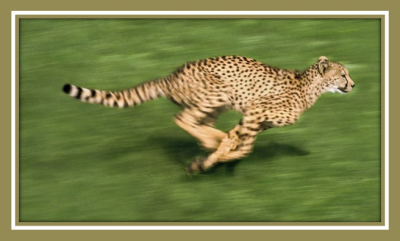|

Running against time
First, a few facts about cheetahs:
- We all know that cheetahs are the fastest land mammals. But how fast do they run? Some say close to 120km/hr, but that is not really believable. A captive cheetah in the Cincinnati Zoo was clocked at 97km/hr – but that’s a zoo animal and not a fit wild cheetah. Usain Bolt ran 100m for a world record of 9.58 seconds. A cheetah could do it in a little over 5 seconds.
- But cheetahs cannot keep up this pace for long. They stalk their prey like many other cats and then charge out of their starting blocks at a lightning pace. Unlike Usain, they do not run in straight lines but have to change course often with the help of their tails. Cheetahs tire quickly.
- Cheetahs are most closely related to pumas and jaguarundis. They form a large “clade” with domestic cats, lynxes, ocelots, caracals, etc. They are only distantly related to the other “big cats” like lions, leopards, tigers and jaguars.
- Cheetahs have been shown to have only very limited genetic variability. Cheetahs are so closely related that studies in the 1980s showed that they fully accepted skin grafts from other cheetahs. Cheetahs also suffer from a very high level of sperm abnormalities and do not reproduce well in captivity.
- Cheetah cubs suffer very high mortalities in nature – especially where cheetah populations occur together with lions and hyenas.
- About six subspecies of cheetahs are recognized – Asian, northwestern and central African, eastern African, southern African, and northern African. Likely there are only two major genetic divisions – Asian/western African cheetahs and all other populations.
- The world cheetah population is estimated at about 12,000 – and the country with the most cheetahs is Namibia with about 2,500.
However, Namibia is also the country that is foremost in the number of cheetahs shot as hunting trophies. During the ten years 2003 – 2012, Namibia exported 1,114 trophies – mostly from adult males. From a population of 2,500 cheetahs of all ages and both sexes? 2012 showed an increase of over 200% in cheetah trophy exports from the year before.
Cheetah trophies are mainly exported to Germany, France and Austria. The USA does not allow importation of cheetah trophies as the species has been placed on the US Endangered Species Act. The European Union seems to think cheetahs are just fine to be hunted it would seem?
In Namibia, conservation organizations like the Cheetah Conservation Fund among others accept trophy hunting as part of the cheetah conservation formula .
Better run fast cheetahs – it would seem there is not much time left on your clock in Namibia. Trophy hunting in addition to natural mortality and problem animal control by farmers and disease problems and genetic problems might just win the running race?
Picture credit: http://bbc.in/XDhFB3
If you have not already signed up to our mailing list, you can add your name here and keep up to date with our ongoing work and, most importantly, DONATE to support our work to conserve the remaining fragile lion populations. Thank you.
|




